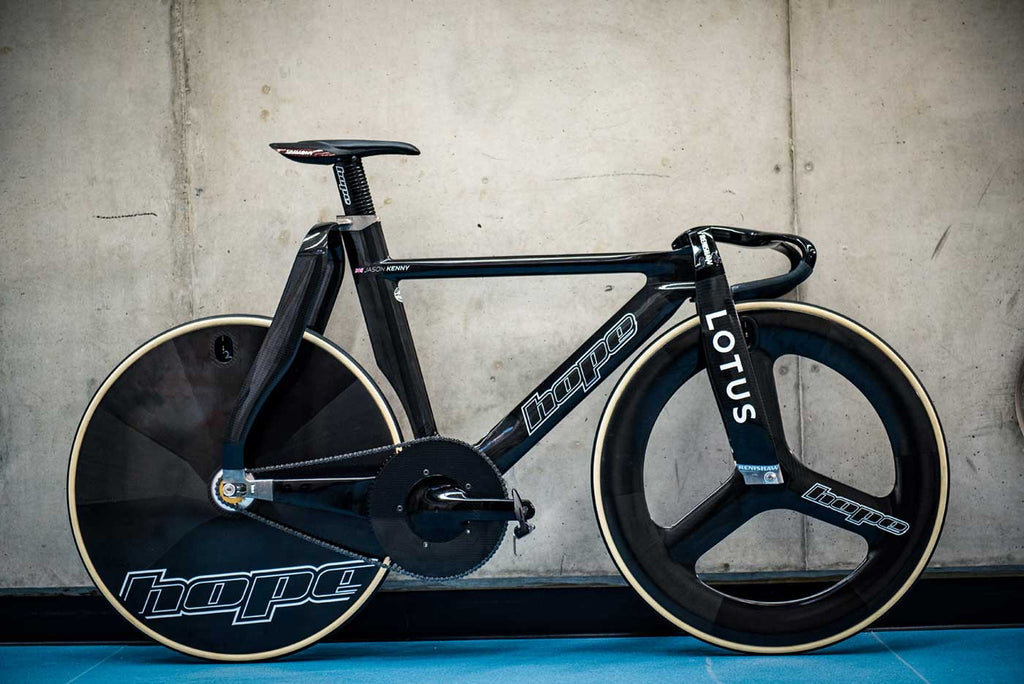Despite having only a single gear, Hope’s HB.T track bike is likely the most expensive production bike at the upcoming Rouleur Live show. Recently used by Laura and Jason Kenny, plus Katie Archibald to claim gold medals at the Tokyo Olympics, each frameset costs a chunky £15,550 plus VAT. We were lucky enough to snatch a close look at the very bike that carried Jason Kenny to gold in the keirin final last month, and we were rather taken with it.
Designed and made in Barnoldswick, Lancashire, the project that led to the creation of this blade-like machine reached its culmination with the rescheduled games in Japan. Already seen at various World Cups and World Championship events, the bike was initially designed by Tony Purnell, head of technology at British Cycling, with a view to its use at the 2020 Olympics in Tokyo.

The bike’s unusual form, with extremely wide, flared fork legs and similarly broad and flat seatstays, springs from a desire to consider both rider and bike as a single unit. Radically different to the design of other bikes, yet still conforming to the UCI’s many stipulations, another recently enforced rule means that any bike used in competition must also be commercially available. Allowing anyone wealthy enough to afford it could get their name in Hope’s order book; in theory, this also means nothing is stopping another national association from ordering a batch for its riders.
Related – First Look: The new Ribble Ultra
We had seen studio shots and TV footage of the HB.T whizzing around the velodrome, but we managed to cast our eyes on Jason Kenny's bike in the flesh at the launch of the UCI’s Champions Track League in London last week.
The Champions Track League is a new format that will be held across six weekends, starting in Palma, Mallorca, on the 6th November and culminating on 11th December. With the London round taking place on the 3rd and 4th of December, we got an opportunity to take a look at the bikes the Team GB riders will be using. However, sadly, we weren’t allowed to take a spin and see if they offered any improvement in our flying lap time.
Quick bike change

Replacing the Cervélo bikes Team GB used at the Rio 2016 games, UK-based Hope was initially tasked to create a single machine as a proof of concept. Essentially providing Team GB with a backup if it wanted to switch suppliers at short notice, in the end, that’s precisely what happened.
Easily the most radical track bike created since the UCI introduced stricter design rules in the 1990s, the HB.T track bike Hope built brings to fruition ideas Team GB has been experimenting with for years. These include the bike’s unusually wide stance and flat, narrow tubes. Viewed from the side, the HB.T track looks almost conventional. Yet seen from the front, its bulk instantly disappears as it becomes apparent how broad and thin each member of the frame and fork is.

Allowing improved airflow alongside the wheels while also smoothing its progress over the rider’s rapidly revolving legs, the design relies heavily on recent advances in composites and 3D printing. It’s these advances that have allowed Hope to build a bike that accomplishes this trick while also resisting the incredible torque produced by elite riders.
Bringing it all home

Despite being a UK-based company, the choice of Hope as a supplier for the notoriously meticulous Team GB squad came as something of a surprise. However, although Hope had experimented with producing carbon bikes, it was as much the firm’s expertise working with metal that attracted Purnell’s interest.
This is because every carbon frame first emerges from an aluminium mould. A field in which Hope has extensive experience and the necessary machinery, its capabilities allowed it to rapidly produce the moulds required for creating prototype bikes. Allowing any modifications to be quickly achieved, keeping both mould making and carbon lay-up in-house allowed the entire project to proceed much quicker than if the two processes had been divided. Needing to be produced in multiple sizes, eventually, every team GB athlete would be provided with their own bike.


First shown in public towards the end of 2019, the HB.T debuted at the UCI Track Cycling World Cup in Belarus. Aiming to make the prerequisite number of appearances before being allowed to compete at the Olympics, Team GB found its plans postponed as the games were pushed back a year due to the pandemic.
When they eventually took place this year at the Izu Velodrome, the squad again topped the medals table. With Jason Kenny winning the keirin, plus Katie Archibald and Laura Kenny victorious in the madison, how much was down to the HB.T track bikes is impossible to say.
 Hope’s engineers have put the figure somewhere between 2-3% versus a comparable track frame. A slight difference in an already very competitive field; given the results it’s hard to imagine anyone involved won’t feel they’ve had a good return on their investment.
Hope’s engineers have put the figure somewhere between 2-3% versus a comparable track frame. A slight difference in an already very competitive field; given the results it’s hard to imagine anyone involved won’t feel they’ve had a good return on their investment.
If you fancy getting close up with the HB.T your two best options will be to pop by the Hope booth at Rouleur Live (4th-6th November), or wait a little longer and head a little further east to the UCI Track Champions League (3-4th December) at London’s Olympic Velodrome.
Tickets for Rouleur Live can be found here, while more information on the UCI Track Champions League is available here.






























